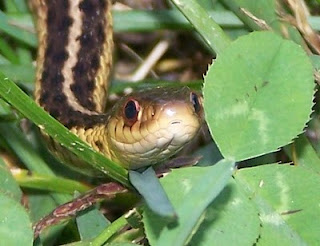 | |
| Garter snake (Thamnophis sirtalis), Photo by Brad Sylvester |
If I manage to get a closer look, or a photograph that I can enlarge later, then it gets easier to determine whether the snake happens to be a garter snake or a ribbon snake.I found one in my yard today (the first reptile detailed in this blog!) and managed to take a number of photos.
The garter snake is completely harmless. Although it will try to bite if attacked, it has no fangs and no poison. Its bite cannot even break the skin or deliver enough pressure to hurt or cause any damage at all to people. The snake's biggest defense is its musky smell. When scared or threatened in exudes a strong unpleasant odor. It's not overpowering or anything, but I can imagine that if I were a predator looking for a meal, it would be unpleasant enough to make me hesitate to want to taste any animal that smelled like that. It doesn't seem to dissuade free-range chickens from killing and eating snakes, however.
Garter snakes have a fairly varied diet compared to some other snakes. They eat insect, earthworms, small frogs and toads, and pretty much anything small enough for them to fit into their mouth. The garter snake can open its mouth quite wide on its loosely hinged jaws, but it is a myth that snakes dislocate their jaws to swallow prey.
I most often see garter snakes hunting on my lawn or basking in the morning sunshine. As cold-blooded animals, they rely on warmth absorbed from their environment to power their metabolism and provide them with energy.
Garter snakes give birth to live young. They babies are fully formed and independent as soon as they are born. One of the oddest sites you might run across is what is called a breeding ball of garter snakes. Although they will mate in pairs, if multiple males come across a female during the breeding season, they will all entwine their bodies around her in a writhing ball of snakes.
Quick Facts about garter snakes (Thamnophis sirtalis):
Diet: Garter snakes eat insects, frogs, toads, earthworms, fish, bird eggs, carrion, slugs, and just about anything that moves that is small enough to swallow.
Where do garter snakes live? Garter snakes live in a wide variety of habitats from forests to to swamps to the front lawn of suburban homes from Alaska to Florida and everywhere in between including every U.S. state except Hawaii and most of Canada.
Where do garter snakes go in the winter? garter snakes hibernate in the winter. They will seek shelter in houses, in burrows made by other animals, under rocks, or in other natural crevices that protect them from the snow. They often hibernate in large groups, but may also be found hibernating alone.
What is the lifespan of garter snakes? They can live about ten years in the wild.
Notes: Another defense used by garter snakes is a detachable tail. If caught by the tail, it breaks off and wriggle while the snake escapes. It will grow back over time.
Garter Snake Taxonomy:
Kingdom: Animalia
Phylum: Chordata
Class: Reptilia
Order: Squamata
Suborder: Sepentes
Family: Colubridae
Subfamily: Natricinae
Genus: Thamnophis
Species: Thamnophis sitralis
I have a garter snake in my yard, he's quite large. I worried about how he'd make it through the winter, I was even contemplating bringing him in, under a heat lamp. But I read up and decided he'd probably be happier outside under my shed, where he seems to go when he's in danger. I've even killed crickets or grasshoppers to put outside the den door, and find them gone the next day.
ReplyDelete